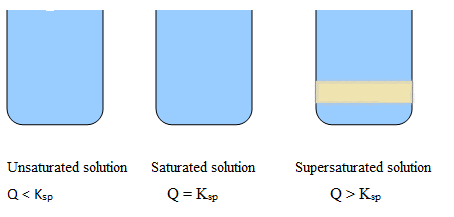Difference Between Saturated and Supersaturated Solution
Key Difference – Saturated vs Supersaturated Solution
Let us first briefly look at the concept of saturation before moving on to a complex analysis of the difference between Saturated and Supersaturated Solution. Solutions are made by dissolving a solute in a solvent. The two chemical properties of “saturation” and “supersaturation” in solvents mainly depend on the solubility of the solute in the solvent. At a given temperature, the solubility of a solute in a particular solvent is a constant (Q).
Q is defined as the ion product of the solute.
Example: Solubility of AgCl in water (QAgCl) = [Ag+][Cl–]
Generally, if we keep on adding the solute into the solvent, there is a maximum quantity which we can add dissolve in the solvent. After a certain limit, the solute starts to precipitate in the solvent. It becomes a supersaturated solution after this limit. It is called a saturated solution when we can dissolve the solute with no formation of a precipitate.
The key difference between Saturation and Supersaturation is that, Saturation is the state at which a solution of a substance can dissolve no more of that substance, and additional amounts of it will appear as a separate phase while supersaturation is a state of a solution that contains more of the dissolved material than could be dissolved by the solvent under normal circumstances.
What is a Saturated Solution?
There is a very limited number of compounds which are infinitely soluble in a solvent; which means, we can mix the solute in the solvent in any proportion to dissolve without forming a precipitate. However, most of the solutes are not infinitely insoluble; they form a precipitate if you add more solute into the solvent.
Saturated solutions contain the maximum number of solute molecules it can dissolve with no precipitation.
What is a Supersaturated Solution?
Supersaturated solutions are formed if you add additional solute to the saturated solution. In other words, it is the condition in a saturated solution, when you add some additional quantity of solute into the solution. Then it will start to form a precipitate in the solution because the solvent has exceeded the maximum quantity of solute molecules it can dissolve. If you raise the temperature of the solvent, you can make a saturated solution by dissolving the solute molecules.

The supersaturation of sugar in water allows for rock candy to form.
What is the difference between Saturated and Supersaturated solution?
Definition of Saturated and Supersaturated Solution
Saturated Solution: At a particular temperature, a solution is said to be a saturated solution, if it contains as much as solute molecules which the solvent can hold.
Supersaturated Solution: At a particular temperature a solution is said to be a supersaturated solution if it contains more solute molecules it can dissolve.
Chemical Explanation
For saturated solutions; Q = Ksp (No precipitation)
For supersaturated solutions; Q > Ksp (Precipitate will form)
Where;
Q = solubility (reaction quotient)
K sp= Solubility product (mathematical product of dissolved ion concentrations raised to the power of their stoichiometric coefficients)
Example: Consider dissolving Silver Chloride (AgCl) in water.
AgCl – Solute and Water – Solvent

AgCl has dissolved in water A large quantity of AgCl has dissolved in water.
The solution is clear The precipitate is clearly visible
Q= [Ag+][Cl–] = Ksp Q= [Ag+][Cl–] > Ksp
Where,
[Ag+]= Concentration of Ag+ in water
[Cl–] = Concentration of Cl– in water
For AgCl, Ksp = 1.8 ×10–10 mol2dm-6
How can we make saturated and supersaturated solutions?
Both saturated and supersaturated solutions are formed when you keep on adding a particular solute into a solvent. At a given temperature, first, it forms an unsaturated solution and then, a saturated solution and finally the supersaturated solution.
Example: Dissolving salt in water
 Unsaturated Solution: Less amount of salt in water, clear solution, no precipitation.
Unsaturated Solution: Less amount of salt in water, clear solution, no precipitation.
Saturated Solution: The maximum amount of salt is dissolved in water, Colour of the solution slightly changes, but no precipitation.
Supersaturated Solution: More salt is dissolved in water, Cloudy solution, precipitation is visible.
Image Courtesy:
“Rock-Candy-Sticks” by Evan-Amos – Own work. (CC BY-SA 3.0) via Commons
ncG1vNJzZmivp6x7pbXFn5yrnZ6YsqOx07CcnqZemLyue8OinZ%2Bdopq7pLGMm5ytr5Wau26%2FwK2sq5mkmrFurc2dZK%2BrXajCsbHRrJitraKWwaawjKympa2knryvew%3D%3D